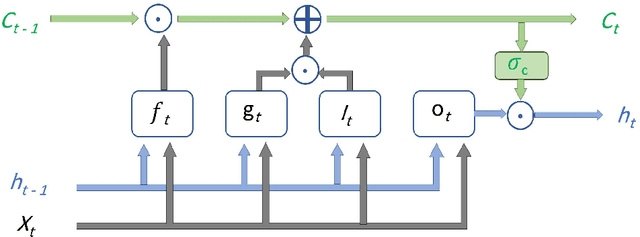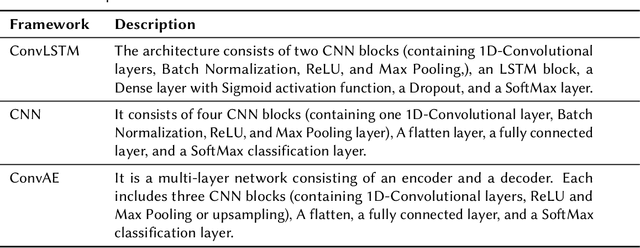Oluwaseyi Ogunfowora
A Transformer-based Framework For Multi-variate Time Series: A Remaining Useful Life Prediction Use Case
Aug 29, 2023Abstract:In recent times, Large Language Models (LLMs) have captured a global spotlight and revolutionized the field of Natural Language Processing. One of the factors attributed to the effectiveness of LLMs is the model architecture used for training, transformers. Transformer models excel at capturing contextual features in sequential data since time series data are sequential, transformer models can be leveraged for more efficient time series data prediction. The field of prognostics is vital to system health management and proper maintenance planning. A reliable estimation of the remaining useful life (RUL) of machines holds the potential for substantial cost savings. This includes avoiding abrupt machine failures, maximizing equipment usage, and serving as a decision support system (DSS). This work proposed an encoder-transformer architecture-based framework for multivariate time series prediction for a prognostics use case. We validated the effectiveness of the proposed framework on all four sets of the C-MAPPS benchmark dataset for the remaining useful life prediction task. To effectively transfer the knowledge and application of transformers from the natural language domain to time series, three model-specific experiments were conducted. Also, to enable the model awareness of the initial stages of the machine life and its degradation path, a novel expanding window method was proposed for the first time in this work, it was compared with the sliding window method, and it led to a large improvement in the performance of the encoder transformer model. Finally, the performance of the proposed encoder-transformer model was evaluated on the test dataset and compared with the results from 13 other state-of-the-art (SOTA) models in the literature and it outperformed them all with an average performance increase of 137.65% over the next best model across all the datasets.
Reinforcement and Deep Reinforcement Learning-based Solutions for Machine Maintenance Planning, Scheduling Policies, and Optimization
Jul 07, 2023Abstract:Systems and machines undergo various failure modes that result in machine health degradation, so maintenance actions are required to restore them back to a state where they can perform their expected functions. Since maintenance tasks are inevitable, maintenance planning is essential to ensure the smooth operations of the production system and other industries at large. Maintenance planning is a decision-making problem that aims at developing optimum maintenance policies and plans that help reduces maintenance costs, extend asset life, maximize their availability, and ultimately ensure workplace safety. Reinforcement learning is a data-driven decision-making algorithm that has been increasingly applied to develop dynamic maintenance plans while leveraging the continuous information from condition monitoring of the system and machine states. By leveraging the condition monitoring data of systems and machines with reinforcement learning, smart maintenance planners can be developed, which is a precursor to achieving a smart factory. This paper presents a literature review on the applications of reinforcement and deep reinforcement learning for maintenance planning and optimization problems. To capture the common ideas without losing touch with the uniqueness of each publication, taxonomies used to categorize the systems were developed, and reviewed publications were highlighted, classified, and summarized based on these taxonomies. Adopted methodologies, findings, and well-defined interpretations of the reviewed studies were summarized in graphical and tabular representations to maximize the utility of the work for both researchers and practitioners. This work also highlights the research gaps, key insights from the literature, and areas for future work.
Synthesizing Rolling Bearing Fault Samples in New Conditions: A framework based on a modified CGAN
Jun 29, 2022



Abstract:Bearings are one of the vital components of rotating machines that are prone to unexpected faults. Therefore, bearing fault diagnosis and condition monitoring is essential for reducing operational costs and downtime in numerous industries. In various production conditions, bearings can be operated under a range of loads and speeds, which causes different vibration patterns associated with each fault type. Normal data is ample as systems usually work in desired conditions. On the other hand, fault data is rare, and in many conditions, there is no data recorded for the fault classes. Accessing fault data is crucial for developing data-driven fault diagnosis tools that can improve both the performance and safety of operations. To this end, a novel algorithm based on Conditional Generative Adversarial Networks (CGANs) is introduced. Trained on the normal and fault data on any actual fault conditions, this algorithm generates fault data from normal data of target conditions. The proposed method is validated on a real-world bearing dataset, and fault data are generated for different conditions. Several state-of-the-art classifiers and visualization models are implemented to evaluate the quality of the synthesized data. The results demonstrate the efficacy of the proposed algorithm.
 Add to Chrome
Add to Chrome Add to Firefox
Add to Firefox Add to Edge
Add to Edge